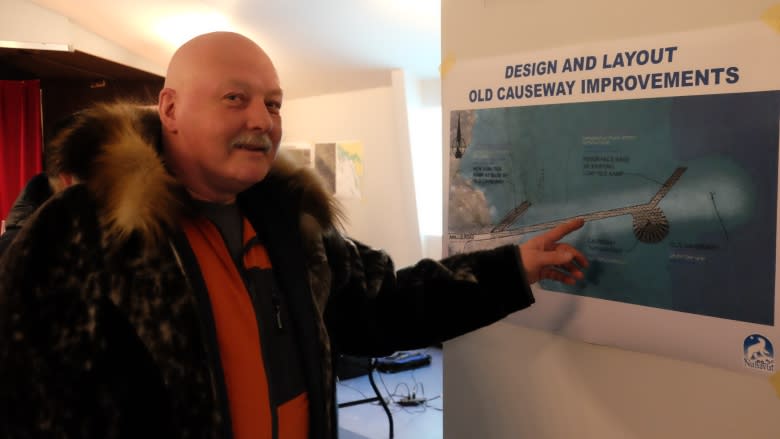Public gets first look at plans for Iqaluit's deep sea port
People in Iqaluit got their first look at plans for the city's deepwater port on Thursday night, but early designs left a lot of questions.
The plan allows for one ship to dock at the wharf, while a second can offload using a barge-and-ramp method, which is an upgraded, but similar process to how sealifts currently operate.
The project's lead Paul Mulak says the port designs are very preliminary, estimating that they are only five per cent finished.
But Iqaluit resident Sim Akpalialuk, who attended the meeting, said the design plans looked well on their way.
He questioned the design wondering if a two or three-pronged port would make better use of the space.
The port is expected to take up 40,000 square metres or just about seven Canadian football fields.
While feasibility studies were conducted, Akpalialuk says more community input even before preliminary design plans were worked up would have been beneficial.
"I would have liked to have seen a lot of the actual users in the community get involved, the businesses, the local people, the people that have boats or have skidoos in winter that access this area all the time."
Do the plans dream big enough?
A number of attendees expressed interest in whether the business plan adequately addressed their hopes for economic growth.
Concerns centred around preparations for the possibility of visiting cruise ships, coast guard and navy vessels.
Having an improved port could boost Iqaluit's position as a gateway for remote Northern locations, especially as the city's airport is expecting the opening of a new terminal this summer.
Boat owner Glenn Williams wanted to know if offshore fishing vessels would begin using Iqaluit for resupply as opposed to stopping in Greenland or Labrador.
"If it's utilized by all these different types of vessels do we have the capacity? And that question wasn't answered tonight, so we don't know whether our port that we're getting designed should have one berth or two berths and we're getting one berth, so it can handle one ship at a time. Will that be sufficient for our short shipping season?"
Mulak said Nunavut's Community and Government Services is managing the project and they see the port primarily as a commercial facility used for offloading dry cargo, though fishing vessels were considered in the design.
Still lots of unknowns
The project is being developed in tandem with the small craft harbour, and he suspects that if cruise ships visit they might opt to put passengers on smaller boats and take them through there instead of driving them by the city dump.
It will be a Government of Nunavut facility, but who will run the port, whether the public will have access, and what environmental mitigation is required has not yet been determined.
Some dredging will be required to create the stable sea-floor base needed to build the marine infrastructure; the amount will be determined after further geotechnical study.
Construction on the port will start in the summer of 2018, continue through the next summer and be fully operational for the 2020 ice-free season.
The next community consultation will be in the next four to six weeks.



